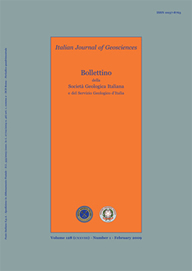
La ricostruzione dello scuotimento del terremoto del Garda del 2004 (ML=5.2)
G. Franceschina(*), V. Pessina(*), D. Di Giacomo(*), M. Massa(*), F. Mulargia(**), S. Castellaro(**) & M. Mucciarelli(***)
(*) INGV Sezione di Milano - Pavia, via Bassini, 15 - 20133 Milano.
(**) Dip. Fisica, Università di Bologna, Viale Berti-Pichat, 8 -40127 Bologna.
(***) DiSGG, Università della Basilicata, Viale dell'Ateneo Lucano, 10 - 85100, Potenza. Corresp. author's telephone, fax and e-mail: +39 0971 205094, 205070, marco.mucciarelli@unibas.i
Volume: 128 (2009) f.1
Pages: 217-228
Abstract
The 2004 Garda (Northern Italy) earthquake (ML=5.2) is modeled through both point-source and extended-source simulations, in order to reproduce the anisotropy of the macroseismic observations in the epicentral distance range from 5 to 15 km Comparison between synthetic and observed data is performed in terms of macroseimic intensities (IMCS) considering observations reported at municipalities with only ground conditions classified as «rock» or «stiff soil», up to 40 km epicentral distance; further agreement between simulations and observations is attained with acceleration data recorded at the station GVD (13.3 km epicentral distance) of the Italian Accelerometric Network (RAN). Point source simulations are calculated through empirical predictive equations in terms of macroseismic intensity. Extended source modeling is performed in terms of peak ground motion parameters, successively converted in synthetic intensities by empirical relationships. Notwithstanding the moderate magnitude of the event, extended source simulations, requiring plausible hypothesis on both source geometry and attenuation properties of the propagating medium, confirm the anisotropy observed in the distribution of the macroseismic intensity at a regional scale (30×30 km2). The observed IMCS distribution also presents local scale heterogeneities (with inter-site distance <3 km) possibly due to geological or geo-morphological site effects and/or soil-structure interaction. To this aim, examples of the investigations performed at specific sites by noise measurements and building frequency measurements are also presented.
Keywords
Moderate earthquake, macroseismic intensity, point-source, extended source simulation, ground shaking scenario, site effects, seismic noise, building frequency.
Get Full Text